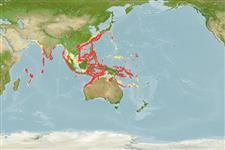Environment: milieu / climate zone / depth range / distribution range
Ecología
marino; salobre demersal; rango de profundidad 70 - 600 m (Ref. 3132). Deep-water; 35°N - 22°S, 55°E - 168°E
Indo-Pacific: Seychelles, Indonesia and northwestern Australia. Also from southern Japan to the northern South China Sea (Ref. 559).
Tamaño / Peso / Age
Maturity: Lm ? range ? - ? cm
Max length : 17.0 cm SL macho / no sexado; (Ref. 43239); 13.0 cm SL (female)
Short description
Claves de identificación | Morfología | Morfometría
Espinas dorsales (total) : 4; Radios blandos dorsales (total) : 8; Espinas anales: 0; Radios blandos anales: 7. First dorsal spine elongate and filamentous. First dorsal ray elongate in the male but not in the female. Five median caudal rays filamentous in the male. First dorsal fin with a large dark mark which becomes faint with growth. Second dorsal fin yellow with many pinkish oblique lines. Attains 18 cm SL.
Inhabits deep trawling grounds (Ref. 3132). Found in shelf edges (Ref. 43239).
Life cycle and mating behavior
Maturities | Reproducción | Spawnings | Egg(s) | Fecundities | Larva
Randall, J.E. and K.K.P. Lim (eds.), 2000. A checklist of the fishes of the South China Sea. Raffles Bull. Zool. Suppl. (8):569-667. (Ref. 36648)
IUCN Red List Status (Ref. 130435)
Threat to humans
Harmless
Human uses
Pesquerías: comercial
Herramientas
Special reports
Download XML
Fuentes de Internet
Estimates based on models
Preferred temperature (Ref.
123201): 11.3 - 22.8, mean 15.5 °C (based on 328 cells).
Phylogenetic diversity index (Ref.
82804): PD
50 = 0.5000 [Uniqueness, from 0.5 = low to 2.0 = high].
Bayesian length-weight: a=0.01148 (0.00455 - 0.02896), b=2.92 (2.70 - 3.14), in cm total length, based on LWR estimates for this (Sub)family-body shape (Ref.
93245).
Nivel trófico (Ref.
69278): 3.6 ±0.4 se; based on size and trophs of closest relatives
Resiliencia (Ref.
120179): Medio, población duplicada en un tiempo mínimo de 1.4-4.4 años (Preliminary K or Fecundity.).
Fishing Vulnerability (Ref.
59153): Low vulnerability (11 of 100).
